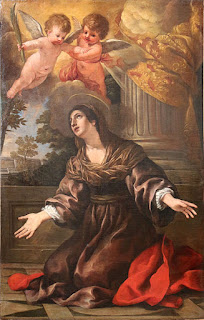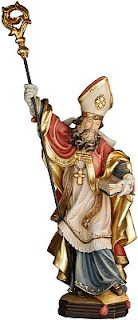At the same time, though, we’ve also got Adelelmus, Dwynwen, Eudoxia of Canope, Tortgith of Barking, Projectus, and Poppo. Did I ever mention that there are a heck of a lot of saints out there?
#10 Ladislao Batthyány-Strattmann (Jan 22)
Otherwise known as St. Quite-a-Mouthful.
Ladislao is one of those rare saints (he’s actually only a Blessed) who is not only a layman, but married as well. Sounds like he and his wife did follow the precepts of Natural Family Planning however – they had 13 kids!
Ladislao is probably best known as a doctor. He was a renowned opthamologist and opened his own clinic, where he treated everyone no matter of their ability to pay.
Ladislao also so happened to be a real honest-to-goodness prince.
Also, he had a really big head
#9 Angela Merici (Jan 27)
Representation: tall ladder with young women climbing it
So, yeah, I can picture it in my mind. That said, though, I’m not sure I totally get it.
St. Angela Merici was the foundress of the Ursulines, an order dedicated to the teaching of girls and young women. She also made a trip to the Holy Land, where she first lost and then recovered her vision. We’re talking 15th and 16th Century Italy here.
Oh, her representation? It was just a vision she had. You can read all about it right here.
#8 Adelelmus (Jan 30)
Go ahead, say it three times fast.
So, not only does this guy have the great name, but he also just so happens to be the patron saint of butlers. In fact, he’s the only one they have.
Adelelmus did indeed start life out as a manservant. He then, however, became a soldier. And, finally, on a pilgrimage to Rome, he became a Benedictine monk. Maybe he should be the patron saint of job hoppers as well.
Hard to believe, but there are actually two saints named Adelelmus out there. Ours is the guy “from Burgos” (in Spain) The other dude is “from Flanders.” Don’t mix ‘em up, ‘kay!
Actually, Google, I did not mean “adele music”
#7 Julian of Cuenca (Jan 28)
Patronage: basket makers
I don’t know why, but basket weaving has always been the butt of many jokes. It’s the class that the lazy or stupid always take. It’s the merit badge that’s the easiest one to take at Scout camp. It’s what they stereotypically give you as occupational therapy at the local loony bin. It just doesn’t get any respect.
That said, it actually was an important job at one point … oh, back in the 12th Century or so. You know, back when ol’ Julian of Cuenca was doing his thing.
“Is it knit one, purl two; or knit two, purl one
… or purl two, knit two; or …?”
Yup, Julian wove his fair share of baskets in his day. A professor and bishop, he actually did basket-weaving as something of a hobby, and largely to raise money for the poor.
Cuenca? It’s in Spain.
#6 Thomas Aquinas (Jan 28)
Patronage: pencil makers
Pretty well-known guy. I’ll bet you never associated that pencil you have in your hand with him though, did you?
Interestingly, the rest of his patronage is typically associated with more serious, much loftier things – like learning, and academics, and colleges, and philosophers.
I also particularly like some of this guy’s nicknames. You may have heard him called the Angelic Doctor before. Bet you didn’t know, though, that he’s also known as the Dumb Ox?!?!
Anyway, he is arguably the most influential and famous philosopher and theologian the Church ever produced.
Not much of a looker though, I’m afraid
#5 Aquilinus of Milan (Jan 29)
Representation: man with a sword through his neck
Do you mean dead man with a sword through his neck? I certainly hope so, ‘cause, otherwise, this is just kinda creepy.
So, you’re probably wondering how Aquilinus got that particular sword in that particular place, no? Well, turns out he was assassinated in just that manner by some Cathar, Manichaean, or Arian, around the year 650. Seems Aquilinus was raising quite a fuss preaching against these various heretics, and it sounds like one of them did not take too kindly to that.
He’s also known as Aquilinus of Cologne. Cologne is where he went to school; Milan is where he was martyred.
Ah, geez!
#4 Dwynwen (Jan 25)
Hmm, I had a Scrabble rack like this once …
So, first of all, Dwynwen was a girl. In fact, she’s the patron saint of Welsh lovers … er, I mean the Welsh patron saint of lovers … um, the patron saint of lovers in Wales. Yup, that last one.
Here’s how Wikipedia describes her legend:
In the 5th Century, Dwynwen fell in love with Maelon Dafodrill [Dafodrill?!?!]. Maelon returned her feelings but for an undetermined reason, they could not be together. Three hypotheses are that a) Maelon raped Dwynwen despite her wish to remain celibate until after marriage, b) her father forbade the marriage, or c) her father had already promised her to someone else. Dwynwen, distraught by her love for Maelon, prays to fall out of love with him.
After falling asleep, or possibly while still awake in a woods she had run to in her distress, Dwynwen was visited by an angel, who appeared carrying a sweet potion designed to erase all memory of Maelon and turn him into a block of ice. God then gave three wishes to Dwynwen. First she wished that Maelon be thawed, second that God meet the hopes and dreams of true lovers and third that she should never marry. All three were fulfilled, and as a mark of her thanks, Dwynwen devoted herself to God's service for the rest of her life
After falling asleep, or possibly while still awake in a woods she had run to in her distress, Dwynwen was visited by an angel, who appeared carrying a sweet potion designed to erase all memory of Maelon and turn him into a block of ice. God then gave three wishes to Dwynwen. First she wished that Maelon be thawed, second that God meet the hopes and dreams of true lovers and third that she should never marry. All three were fulfilled, and as a mark of her thanks, Dwynwen devoted herself to God's service for the rest of her life
Her feast day, Dydd Santes Dwynwen, is the Welsh equivalent of St. Valentine’s Day.
Hapus to you!
#3 Constantly (Jan 28)
Weird, but you must admit it’s a little better than St. Unceasingly, or the Blessed Relentlessly, or St. Incessantly the Greater.
Not a lot on this saint, so let me just share her complete bio from saints.sqpn.com:
Daughter of Constantine the Great. Healed of an unnamed mortal illness at the tomb of Saint Agnes of Rome, she converted to Christianity. Lived the rest of her life near the tomb with a group of like-minded women that today would be nuns.
#2 Lufthild (Jan 23)
Patronage: Hoboes
Hey, even chronically unemployable, mentally unstable substance abusers need some protection, right? Actually … they probably need a lot of protection, don’t they?
Once again, we’re dealing with a female here. And, once again, we’ve got a pretty skinny bio, so let me again just quote the whole thing (and from the same source):
Abused by a jealous step-mother for her kindness to the poor, Lufthild left home young to live as an often-homeless hermit in and around Cologne, Germany.
That’s either a torch or a turkey leg
#1 Poppo (Jan 25)
Good name for a clown. Bad name for a saint.
Though originally a knight, Poppo had a vision that caused him to renounce the world and become a monk. He would go on to become a prior and abbot, as well as something of a real reformer. That said, saints.spqn.com offers him this rather uncharacteristically backhanded compliment:
He practiced severe personal asceticism, cared nothing for literature, and lacked organization, but managed to bring order and devotion to his houses, earning the love of his brothers and the laity
Poppo was also known as Pappan, Poppone, Poppo the Abbot, and Poppo of Stavelot. I think I like that last one best.
See what I mean!
Honorable Mention
- Tudclyd
- Anicet Hryciuk
- Maimbod
- Blath of Kildare
- Zoticus of Alexandria
- Zama of Bologna
- Publius of Zeugma
- Eudoxia of Canope
- Tortgith of Barking
- Projectus

































